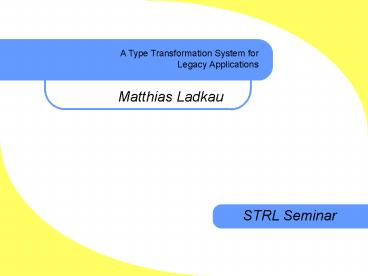Matthias Ladkau - PowerPoint PPT Presentation
1 / 19
Title:
Matthias Ladkau
Description:
... types to Legacy Applications ? Disadvantages of types. Properties of type systems. The approach. Discussion. Introduction to ... Example in Visual Basic ... – PowerPoint PPT presentation
Number of Views:34
Avg rating:3.0/5.0
Title: Matthias Ladkau
1
A Type Transformation System for Legacy
Applications
Matthias Ladkau
STRL Seminar
2
Overview
- Introduction to type systems
- Why introduce types to Legacy Applications ?
- Disadvantages of types
- Properties of type systems
- The approach
- Discussion
3
Introduction to type systems
- Assigning datatypes ("typing") gives meaning to
collections of bits - A type system stipulates the ways typed programs
may behave and makes behavior outside these rules
illegal
In computer science, a type system defines how a
programming language classifies values and
variables into types, how it can manipulate those
types and how they interact. From Wikipedia, the
free encyclopedia
4
Why introduce types to Legacy Applications ?
- Types assist in the comprehension of legacy
systems - The introduction of a type system will bring a
program to a more defined level - A type system helps to exclude some errors during
runtime
5
Why introduce types to Legacy Applications ?
- A type system increases the efficiency of a
program - Type systems help to improve the security of a
system - Programs written in different languages can
interact much more easily if they have well
defined data types and interfaces.
6
Disadvantages of types ?
- Loss of Flexibility
- Difficult when working with reflection or code
generation during runtime - Increases lines of code
7
Properties of type systems
8
Static type checking
- Favoured in compiled languages
- All type checks are done during compiling time
- Can only check if the data processing is right
but not the data itself - Results in compiled code that executes more
quickly.
9
Dynamic type checking
- Appears more often in interpreted languages
- Allows more kinds of code constructs (e.g. eval
functions which executes arbitrary data as
code). - Shortens the edit-compile-test-debug cycle
- Makes metaprogramming more powerful and easier to
use
10
Strong / Weak typing
- A strongly typed language doesnt allow an
operation to succeed on arguments which have the
wrong type.
y 29 Result in C
int x 5, y float c 24.6 y x c Example
java.lang.Error Unresolved compilation
problems Type mismatch cannot convert from
float to int Result in Java
11
Safe / Unsafe typing
- A language is type-safe if it does not allow
operations or conversions which lead to erronous
conditions
var x 5 var y "hi" var z x y Example
in Visual Basic
int x 5 char y "hi" char z x
y Example in C
z 5hi Result in Visual Basic
z Result in C
12
Equational theories
- A type system has always an own definition of
equality - Two extreme cases are
- Nominative type systemsTypes must have the same
name in order to be equal.(e.g. Java, C,
Fortran) - Structural type systemsTypes must have the same
structure in order to be equal.(e.g. Haskell,
Lisp) - A special form of dynamic typing is duck typing
where the language guesses which type is meant
(e.g. Perl, Python, Ruby, Smalltalk)
13
The approach
Transformation
Translation
WSL
P1
P2
Type System 3
Type System 1
Type System 3
Type System 2
Source Code
Type System 1
14
The approach
WSL type safety
Transformation
Translation
WSL
Strong/Safe
Fortran
Weak/Safe
Perl
Weak/Unsafe
C
C
15
The approach
- The different type systems within WSL will help
to reduce the assumed parts of a correct code
translation - The approach will introduce differential levels
of type safety to WSL - The approach will prefer static type checking
16
Design decisions
- How to identify different types ?
- How many levels of different strong type systems
should be defined ? - How typeful should the new type systems be (e.g.
should it be possible to define Types of types
like in Haskell) ? - How much should the maintainer be involved in the
transformation process ?
17
Problems to solve
- How to transform expressions doing pointer
arithmetic ? - How can a type be safely converted into another
? - How to deal with reflection and runtime generated
code (found in reflexive languages) ?
18
To Research
- Which mathematical model can be used as
foundation for this idea ? - What are the limitations of the approach ?
- How to measure the type safety of a system ?
- Maybe the term semantic equivalent can be
defined in some other way than justwp(f1,q)
wp(f2,q) ?q?Q
19
Thanks for your Questions!

